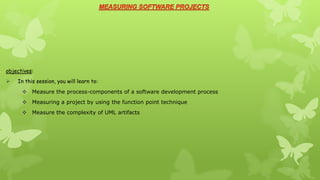This document discusses measuring various aspects of a software development process and project. It describes measuring process components by determining the number of roles, activities, outputs, and tasks. It also discusses measuring a project using function points by identifying files, interfaces, inputs, outputs and inquiries. Finally, it describes measuring the complexity of UML artifacts like use case diagrams, class diagrams, and component diagrams by analyzing elements and relationships.






















